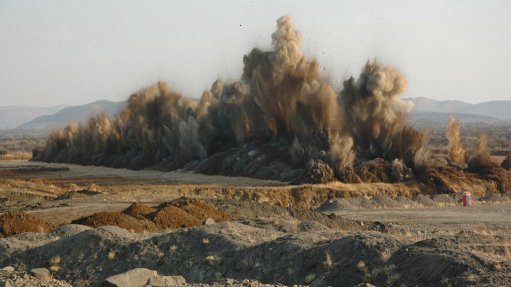
NURTURING BLASTING MASTERS Blasting Consulting Services provides trainees with two-and-half years of blasting training, which covers all aspects of blasting
Specialist blast consulting company Blast Consulting Services (BCS) is undertaking blasting work at several platinum and ferrochrome mining projects in the North West for several mining companies.
BCS MD Marco Olivier says the company is blasting at these mining sites almost every day and that BCS’s contracts vary from short-term, six-month contracts to long-term contracts that can run for up to 12 years.
BCS currently implements blasting technologies that Olivier picked up from a two-year stint in Australia – from 2008 to 2010 – when he worked for several coal mining companies. During this time, Olivier learnt about the blast pack format, which mining contractors use in Australia, mainly for documentation purposes but importantly also for possible legal actions after a blast.
“On completion of my contract in Australia, I returned to South Africa and implemented the blast pack format in BCS’s operations,” he states.
A blast pack comprises comprehensive data on each blast that is fired, which is maintained on file, electronically and in hardcopy, by mining contractors.
The pack also consists of all data from the preplanning phase up to the re-entry phase after a blast; all this data makes it much easier should there be an enquiry or blast-related incident.
“A Department of Mineral Resources investigation is not something to be taken lightly, and the more thorough your blast pack the less blasting contractors have to worry about,” states Olivier.
He says that, previously, local companies only compiled a basic one- or two-page blast report, which contained the details of the blast design and layout.
However, Olivier says the blast pack system ensures that all aspects of the blast are recorded and that any issues that may arise during the blasting process can be found quickly and efficiently.
He points out that the pack requires the sign-off of the mining contractor, the blasting team and the mine before blasting work gets under way.
Further, Olivier highlights that this system is important in ensuring that the mining company agrees with any blasting undertaken and that there are no uncertainties about the requirements.
He explains that, if mining equipment or a structure on or near a mine site sustains damage from a blast, it is important that there is documented proof of where the fault lies. For example, the mining company may not have heeded the contractor’s warnings about blasting in close proximity to machinery or structures. With documented proof, the contactor cannot be held liable for the damage caused.
Meanwhile, regarding education and training, Olivier highlights that, in most instances, BCS takes on
between two and four trainees yearly. “In November each year, we go to schools near the mines that we are working on to explain why Grade 12 learners should think about pursuing a career in the blasting industry,” he explains.
The company provides these trainees with two-and-half years of blasting training covering all aspects of blasting techniques and methodologies. The trainees accompany BCS’s blasting crews on trips to mine sites.
On completion of the training programme, the company financially assists the trainees in receiving their blasting certification.
Olivier says that, even once the trainees are certified as blast technicians, BCS continues to perform audits on their work to ensure that the highest levels of work efficiency and safety are achieved.
However, he points out that one of the company’s greatest challenges is retaining staff members who have completed their training and have become qualified blasting technicians through BCS’s training programme.